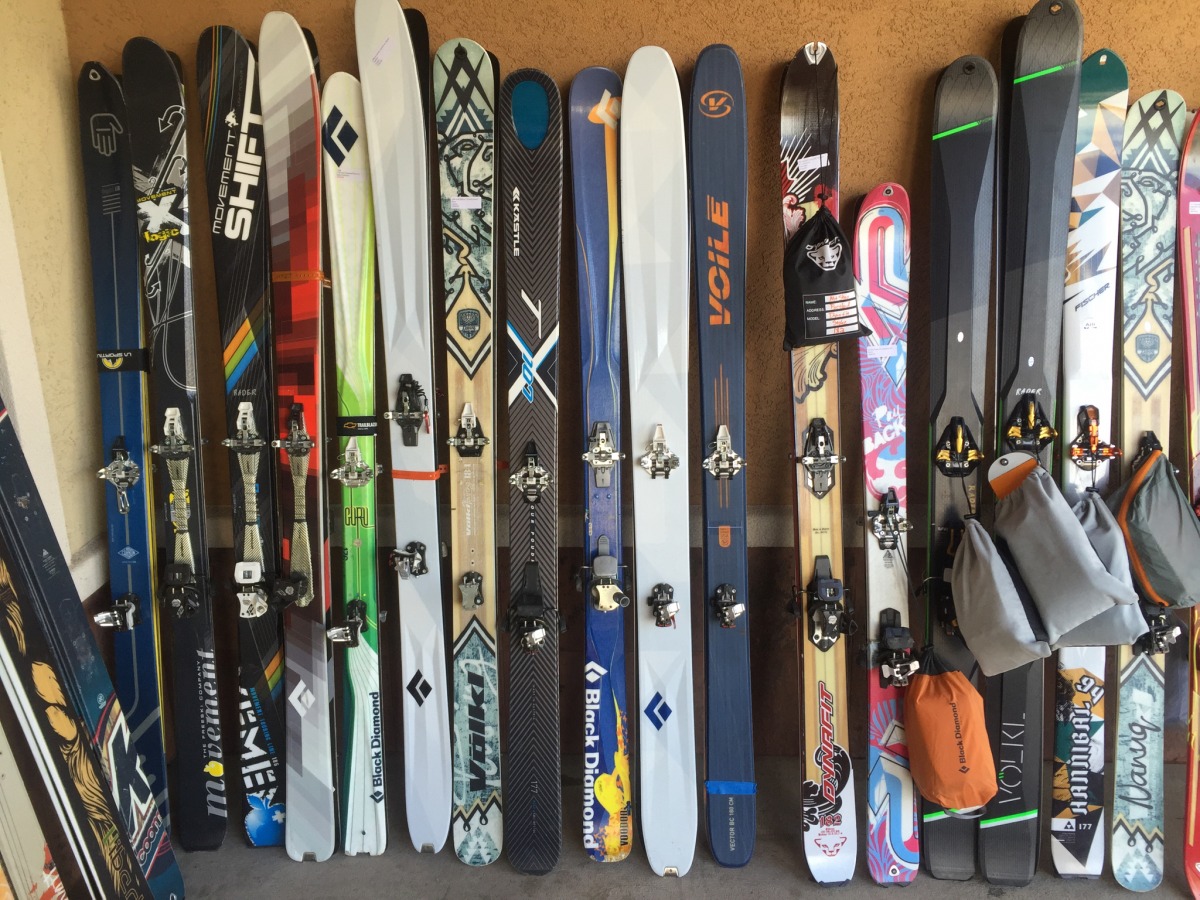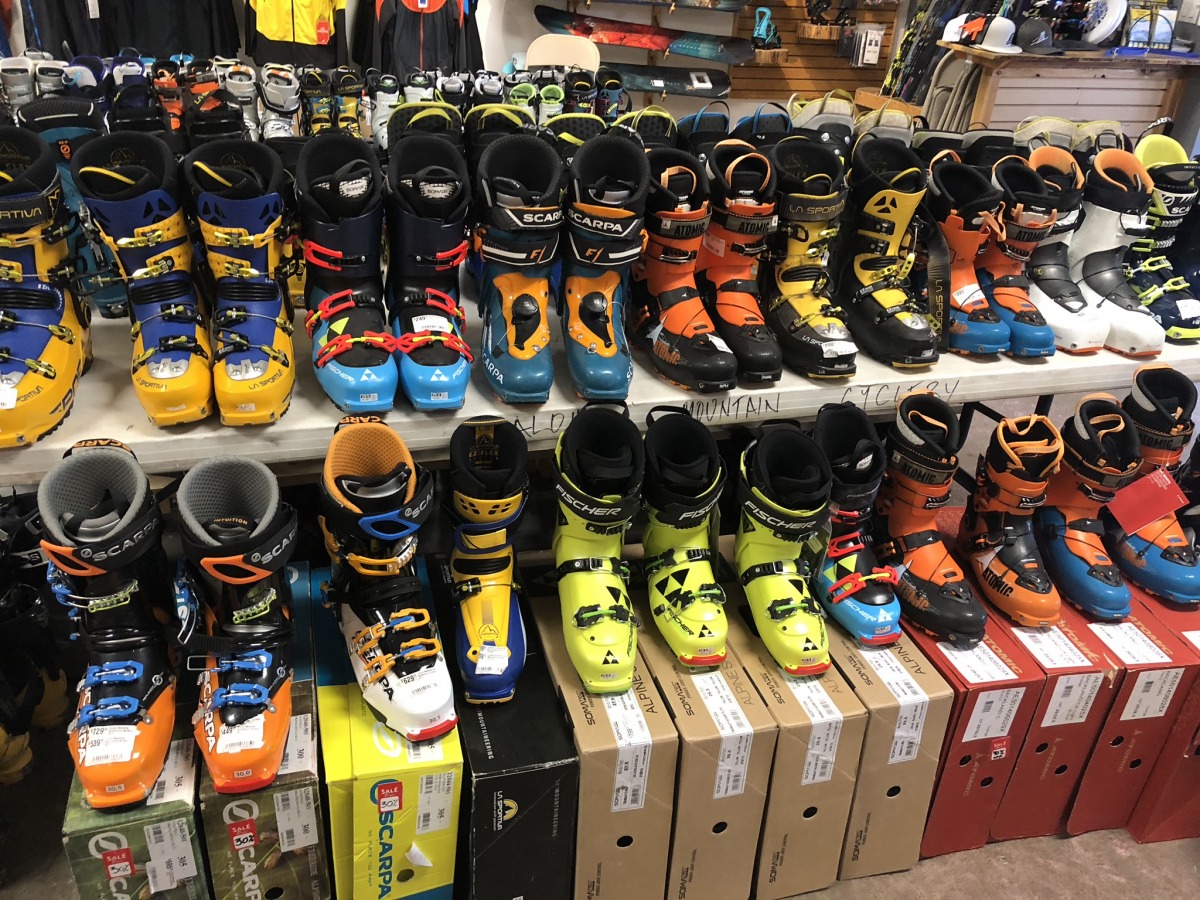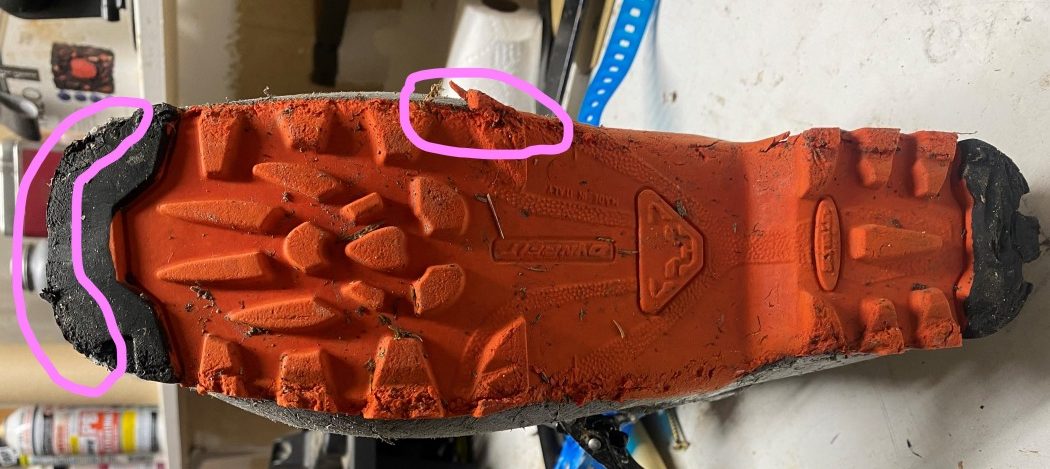Buying gear can be stressful. Who am I kidding? Buying gear is stressful. Nowadays there are so many brands, so many options, it’s hard to keep track, even for someone who has been backcountry skiing for a long time.
Every year, there are more and more people getting into backcountry skiing and shopping used gear is one way to help narrow your choices and save money. It also allows you to ‘try out’ the sport with minimal investment. But not all used gear is worn equally and a bad experience on used gear could turn somebody off from ski touring all together.
When it comes to used gear, a little vetting can go a long way. With all gear, it’s helpful to do some research first like reading gear reviews and checking for product recalls (particularly with bindings and boots). We’re compiling this three-part guide to help used gear buyers be more informed on what to look out for when dipping into thrifty waters. First up: skis, boots, binding, and skins.
Boots: Is buying used worth it?
If there is a part of the set up you may want to consider buying new, it should be boots. I recommend this because finding a used boot that fits well can be difficult. Buying new gives you more options to choose from. While backcountry skiing, one spends a lot more time walking vs. skiing, so keeping feet comfortable is key to having fun.
Whether heading out to buy used or new gear, we suggest supporting your local shop. Not only does this usually come with free boot work (a big plus!) but you can also try on a variety of different boots before making your choice. Ski shops often have demo gear for sale that has more of a known history, depending on how long the shops have been renting it out.
Things to consider when searching for boots
Fit, range of motion in walk mode, stiffness, and weight. A common middle range stiffness is about 90-100, for more aggressive skiers you could consider getting a stiffer boot. If you are looking to do longer tours, greater range of motion and less weight would be the way to go.
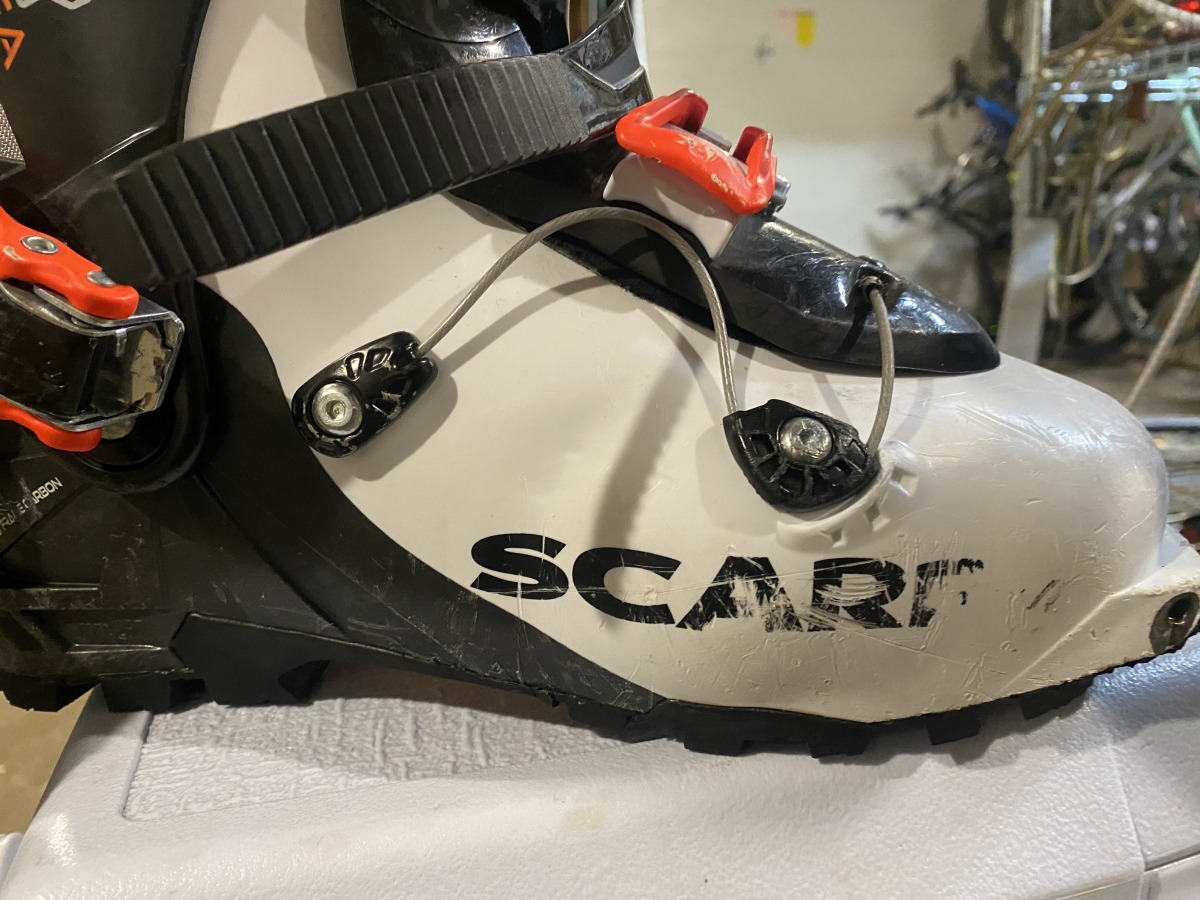
Pictured is slight boot shell wear and tear, however the cables are in good shape and none of the screws are missing.
Versatility
You can get a boot that would work for both alpine as well as tech bindings, this is a good option to consider if you ever want to have a pair of resort skis and use the same boot.
What to check
Once you have an idea what your feet like, check the following if purchasing used boots: the plastic shell (no cracks or other damage), soles (wear and tear), buckles (still functional), liners and toe and heel tech inserts (no rust, no damage)
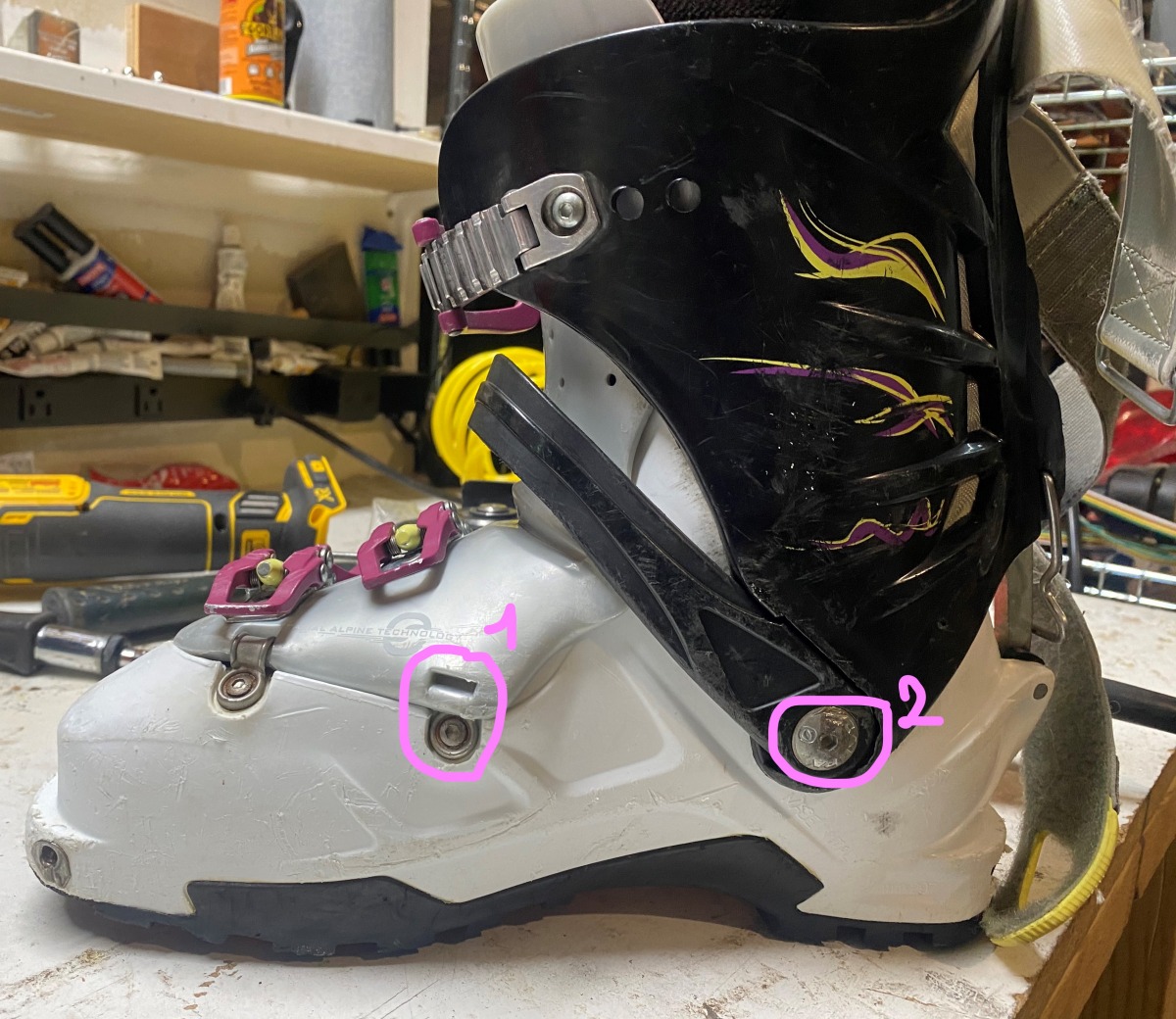
Circle #1 shows a missing hinge, which in the case of this particular boot doesn’t impact its functionality and is also easily replaceable.
Circle #2 shows a common part to go missing, make sure to check that it is in its place. These pivots can wear out and develop play which is nearly impossible to fix and will affect ski performance. One way to check for this is by wiggling the cuff of the boot in ski mode, checking for play.
How used is the liner?
If the shell is in decent condition but the liner isn’t, you can still buy the used boot and then purchase a new liner. This can be a negotiating point to get the seller to drop the price of the boot. Signs of a used liner would be lack of padding, mainly around the heel area of the foot, as well as wear and tear on the outside of the liner. Make so make sure you take the liner out when looking at the boots, even if you have to plug your nose. If you have a liner you can use from a boot you already have, you may be able to use that as well.
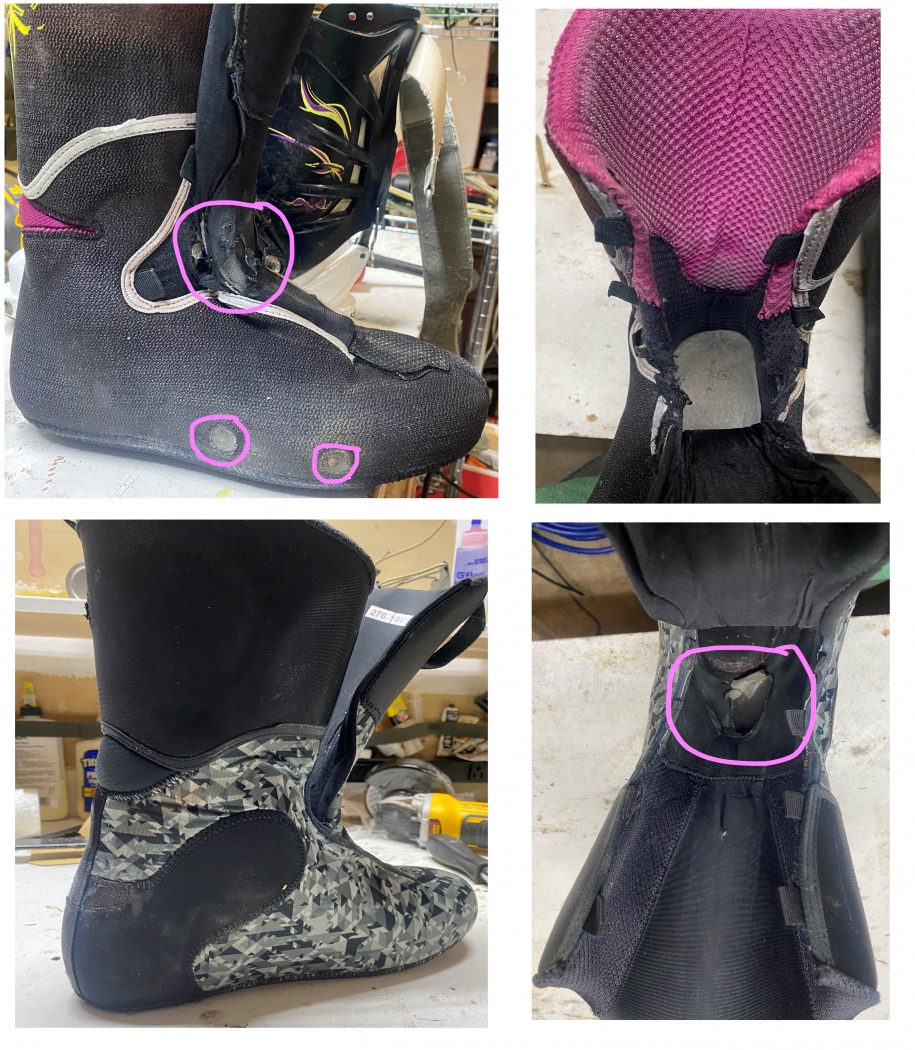
Comparison of two different liners. One has lots of wear and tear on the outside, however the inside looks solid. This in contrast to another liner that looks to have minimum wear and tear on the outside, but is completely worn in the heel on the inside.
If the liner is in good shape, check if it is heat moldable (most of the newer ones are), since you would be able to remold it to fit your foot better. If the boot doesn’t have a heat moldable liner, but the fit is right, that shouldn’t be a problem. It’s worth noting that you may want to upgrade to a moldable liner at some point to ensure you have the best fit.
For more comprehensive tips, check out our Ski Touring Boot Buying Guide Part I and Part II.
Bindings: Is there a risk buying used?
There are two kinds of touring bindings: frame and pin (or “tech”) bindings. Frame bindings are largely out of style, but you’ll still find them on used skis. Tech bindings have evolved to be far lighter and more efficient than the frame variety.
Versatility
Bindings such as the Salomon Shift bridge the gap between tech and alpine binding, giving the tech binding more of an alpine feel, works for both backcountry as well as resort skiing.
Other things to consider
Weight and release values. You can check what your release value needs to be based on your ability and weight (and you can reference the din on your current alpine binding settings). Also, consider whether you want brakes or no brakes. If you’re new to ski touring, brakes can add some assurance.
Check out our 10 tips for buying tech bindings for more comprehensive information on finding the right one for you.
What and how to check wear
It is recommended to bring a boot to check that binding functions as expected. Place the boot into the bindings and take it out. Look for any unexpected loose parts (cracks, loose screws) or difficulty during this process. Check heel risers, make sure they are present and work.
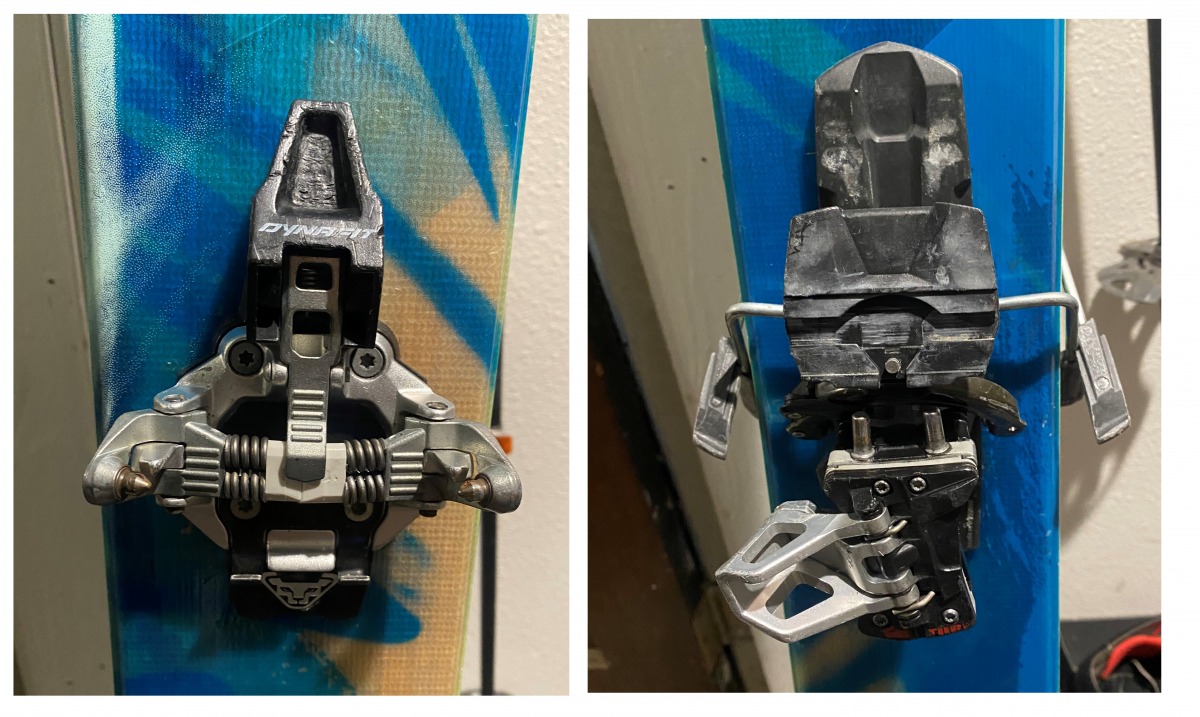
– A well used dynafit radical, brake is missing a plate, however brakes can be replaced. (note: for older models, parts can be harder to find) Some rust present on the pins indicates that bindings may not last for many seasons, but should be okay in the near future. Heel riser is functional and is not missing any parts.
Check the boot fit
Most of the time when buying used it is likely the binding will already be attached to a ski. Bringing your boot can also help you see if a remount (moving the position of heel or toe of the binding) will be needed.
If you are buying demos from your local store, skis will have demo bindings and can be adjusted to fit most sizes. Those bindings tend to be heavier but otherwise work the same as a standard binding.
Skis: What to look and ask for?
Skis are one place where you can and should save money. Yes, it’s nice to get the newest, hottest ski model but if you are on a budget…Older skis in respectable condition will cost less and will still produce stoke. Older alpine skis can also work as touring skis if they fit the profile of a ski you want (though they may be heavier to lug around).
Main areas to check
Base, edges and top sheet. No holes in the bases or edges. Minor top sheet damage is usually not a big issue, unless you can tell that water has gotten underneath and has been spreading along the ski. Big base gouges in the middle of the base are not a deal breaker since they can be repaired, however gouges near edges are often difficult to repair. There is none or very minor rust on the edges; ski edges should be straight.
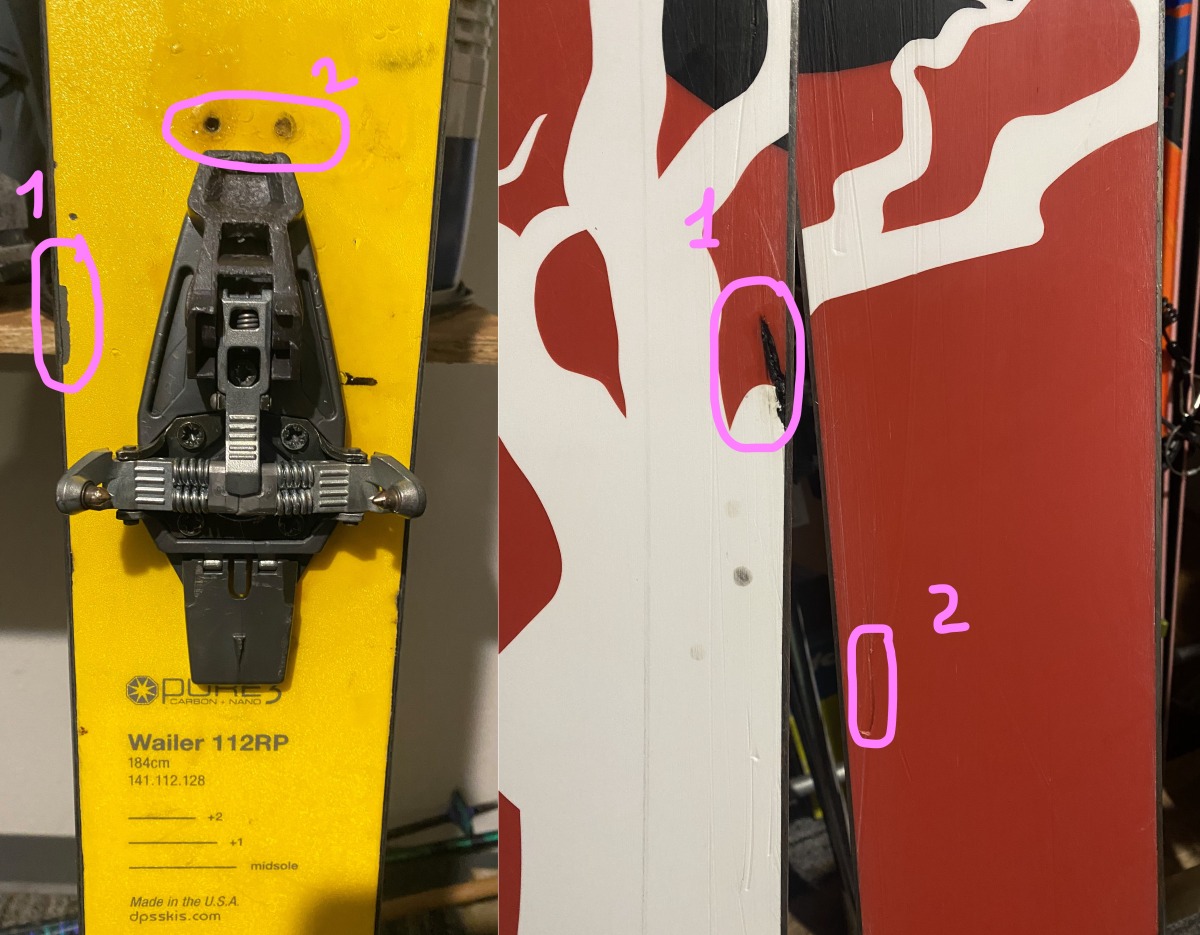
LEFT: Circle #1 shows some visible top sheet scratching, but it is only cosmetic. In circle #2, spot the extra holes that indicate this ski has been mounted at least twice. The holes were not filled with glue or plugs to protect from water getting in, which creates more opportunities for wear.
RIGHT: Circle #1 shows a core shot near the edge, not ideal, however the edge is in decent shape and the patch job appears to have held well (it’s not recently done). Circle #2 shows basic base scratches, which are usually nothing to worry about.
Camber/rocker
It’s worth putting the skis together (base to base) and checking that there is no abnormality in the rocker/camber profile. This can be difficult to see, the two skis should have the same profile. If one has more rocker or camber, that may mean it’s broken or really worn out.
Number of mounts
It is also important to ask (or count, if skis have no bindings) how many times the skis have been mounted (i.e. how many holes are already in the ski) Also check that any holes have been properly plugged or filled.
Width and length
If you’re starting out and want to have a “one ski fits all” quiver, I personally would recommend 100-105 mm width underfoot range. Length of the ski is a personal choice, but generally for a beginner you’d want to go shorter, which would be about your height, since shorter skis are easier to maneuver in challenging terrain
Weight is a factor to consider, but overall a slightly heavier ski is also easier to maneuver vs. a super lightweight touring ski. The average weight for a 100-105 mm underfoot ski is ~1500grams per ski.
Skins: How sticky is too sticky?
Think of climbing skins like bike tires — yes, you can patch them up to extend their lives, but at some point the tread wears thin enough (in this case, the skin ‘hairs’ and glue) and it’s worth purchasing a fresh pair.
There are two main categories of skins out there; nylon, that focus grip and durability, and mohair, that focus on glide and low weight. More grippy skins are going to make it a bit easier on steeper terrain. Skins that have more glide are going to do better during longer flatter skins. There are also versions with a mix of mohair/nylon, but I personally found those tend to be more on the glide side. See our Climbing Skin Myths and Tips for more.
Depending on the climate you are in, you may consider doing a bit of research regarding which skin would work best. Some skin glues and our wet Pacific Northwest weather don’t always mix, and leave glue on the skin. In a dry climate like Colorado, however, the same skin might do better. On the other hand, there are skins that have issues in the cold and dry climates, losing stick quickly and falling off your skis.
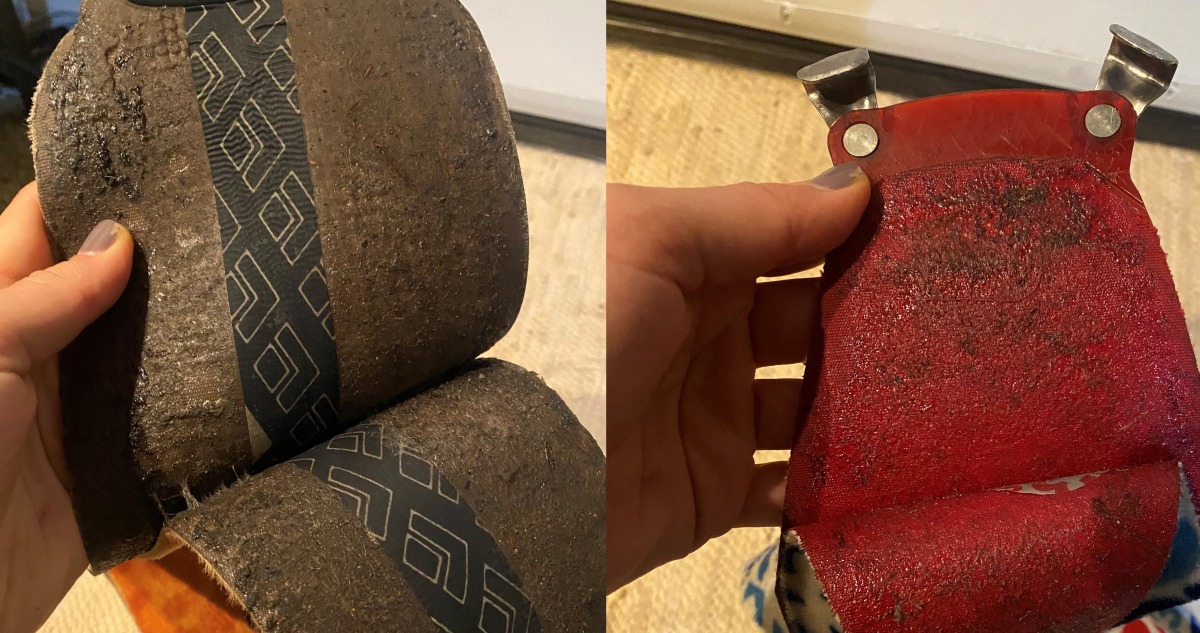
LEFT: Older skins, where glue is bunched up in a few spots. However, when stuck to ski, the skin works well, leaves no residue
RIGHT: Another pair of older skins, also clumps of glue present, but in this case more shiny. This skin leaves lots of glue on the ski. Both will probably need to be re-glued or replaced before long.
Check the stickiness
You want not too little, not too much (leaving no residue on the ski, no one wants pieces of glue on the base).
To test skin stickiness, touch the glue with your fingers and then rub those fingers together. If your finger is overly sticky, that is a sign that glue is coming off the skin. Even though you can reglue a skin, you probably don’t want to have do that right away. Also, unless the used skins are super cheap, regluing might not be the most economical way to go.
Skin size
It is easiest to buy skins and skis together, but if purchasing separately make sure to check the length and width of the skin to make sure it will fit the ski you have
Attachment
Also important is the mechanism for how skins will attach to the skis you have. Not all skins will work for every ski, but there are always at least two types that will. If you are not sure, bring your skis with you to try before you buy!
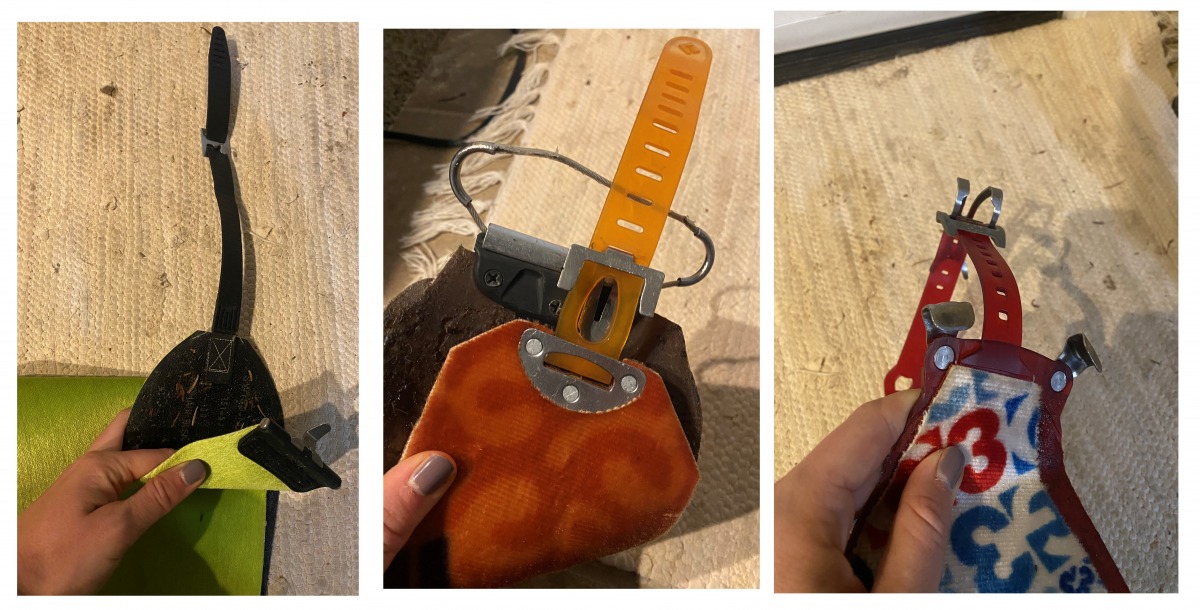
Overview of a few different ways a skin can attach to your ski.The one on the left required the ski to have a hole in the front and back for the skin to work, the other 2 would work with most skis.
Where to shop
Here are a few other places where you can consider checking out:
Facebook marketplace
Ski Classifieds Facebook groups
Evo.com
Craigslist
Ebay
Cripple Creek Backcountry
How much should you expect to spend?
Find some Wildsnow used gear pricing estimates based on its condition (the assumption is the gear had been used for at least a season, more than 10 times). “Excellent” is where it looks almost new, “good” would indicate some wear and tear but mostly minimal, while “fair” shows substantial wear and tear. The obvious disclaimer is that these are just estimates. When shopping for used gear, the person selling is the one to set the price. With that said we do encourage you to negotiate if you believe gear being sold is overpriced.
Skis
Fair: ~70% off original price
Good: ~50% off original price
Excellent: ~20% off original price
Boots
Fair: ~80% off original price
Good: ~50% off original price
Excellent: ~20% off original price
Bindings (probably the item that holds their value the most if well taken care of)
Fair: ~90% off original price (we recommend being careful when buying bindings in this condition, making sure everything is structurally sound)
Good: ~30% off original price
Excellent: ~10% off original price
Skins
Fair: ~90% off original price (if you’re buying skins this cheap, expect to reglue or replace them in very short time)
Good: ~70% off original price
Excellent: ~50% off original price
In the next post in the “Used gear for dummies” we will focus on used avalanche equipment and other miscellaneous gear.
WildSnow Girl, Julia Dubinina, is a weekend warrior chasing snow in winter and sun in summer. A lover of long tours and steep skin tracks, she explores the Pacific Northwest and beyond. When she is not out adventuring, she is working away at her corporate desk job for a software company to make her next adventure happen.

